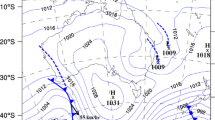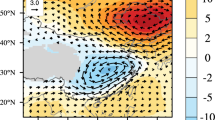Abstract
The 1998 extremely heavy rainfall events over East Asia are investigated through partial lateral forcing (PLF) experiments with the Weather Research and Forecasting model to determine the impacts of the synoptic (SY), intra-seasonal (IS), and inter-annual (IA) forcing across the lateral boundary on the extreme climate anomalies. The large-scale lateral boundary forcing was derived from an ensemble reanalysis dataset and decomposed into climatological, SY, IS, and IA components. The PLF experiments show that the IS forcing not only triggers the monsoon onset and drives two northward propagation events of the subtropical front but also has dominant contributions to the two heaviest rainfall events over the Yangtze River Basin (YRB) and South China, suggesting the critical role of the intra-seasonal variability in the devastating 1998 floods. Previous studies perceived that the northward propagating IS oscillation from the tropics regulates the extreme heavy rainfall of East Asia summer monsoon in 1998. However, we find that the IS forcing from the mid-latitude plays a more important role than the forcing from the tropics in generating the two extreme rainfall events in 1998. During the first extreme event in June, the IS forcing across the western boundary is the major cause of the northward advance of the subtropical front and the heavy rainfall over the YRB and South China, with the IS forcing across the northern boundary providing the second largest contribution. During the second extreme event (July 15–August 5), the IS forcing from the eastern boundary plays a dominant role in driving the southward retreat and northward advance of the subtropical front, causing another heavy rainfall over the YRB and South China. The western and northern IS forcing also has large contributions to the second extreme event. We have estimated the contributions to the seasonal anomalous rainfall by the three types of forcing. The SY forcing tends to have a moderate effect on the YRB rainfall but significant reduction of the rainfall in South China. The IS forcing has dominant contributions to the seasonal-mean rainfall anomalies over all three sub-regions of China (North China, the YRB, and South China). The IA forcing mainly enhances the rainfall in South China but reduces the precipitation in the YRB slightly. This study portends a promising application of regional climate models to identify key factors causing extreme climate events. The PLF methodology can be used to study a broad range of climate phenomena and to understand the effects of variety of dynamic and physical processes in climate variability and predictability.





Similar content being viewed by others
References
Chang C-P (2004) East asian monsoon. World Scientific, Singapore
Chen L-T (2001) The role of the anomalous snow cover over the Qinghai-**zang Plateau and ENSO in the great floods of 1998 in the Changjiang river valley. Chin J Atmos Sci 25:184–192
Ding Y-H (1994) Monsoons over China. Kluwer, Dordrecht
Ding Y-H, Liu Y-J (2001) Onset and the evolution of the summer monsoon over the South China Sea during SCSMEX field experiment in 1998. J Meteor Soc Jpn 79:255–276
Ding Y-H, Zhang Y, Ma Q, Hu G-Q (2001) Analysis of the large scale circulation features and synoptic systems in East Asia during the intensive observation period of GAME/HUBEX. J Meteorol Soc Jpn 79:277–300
Goswami BN, Wu G-X, Yasunari T (2006) The annual cycle, intraseasonal oscillations, and roadblock to seasonal predictability of the Asian summer monsoon. J Clim 19:5078–5099
Kanamitsu M, Ebisuzaki W, Woollen J, Yang S-K, Hnilo JJ, Fiorino M, Potter GL (2002) NCEP-DOE AMIP-II Reanalysis (R-2). Bull Am Meteor Soc 83:1631–1643
Lau N-C, Leetmaa A, Nath MJ, Wang H-L (2005) Influences of ENSO-Induced Indo-Western Pacific SST anomalies on extratropical atmospheric variability during the boreal summer. J Clim 18:2922–2942
Lu RY, Dong HL, Su Q, Ding H (2014) The 30–60-day intraseasonal oscillations over the subtropical western North Pacific during the summer of 1998. Adv Atmos Sci 31:1–7
McPhaden MJ (1999) Genesis and evolution of the 1997–98 El Niño. Science 283:950–954
NCC (National Climate Center of China) (1998) Heavy flooding and climate anomalies in China in 1998. China Meteorological Press, Bei**g
Skamarock WC, Klemp JB, Dudhia J, Gill DO, Barker DM, Wang W, Powers JG (2005) A description of the advanced research WRF. NCAR technical note, NCAR/TN-468 + STR
Tao S-Y, Zhang Q-Y, Zhang S-L (1998) The great floods in the Changjiang river valley in 1998. Clim Environ Res 3:290–299
Uppala SM, Kallberg PW, Simmons AJ et al (2005) The ERA-40 reanalysis. Q J R Meteor Soc 131:2961–3012
Wang B (2006) The Asian monsoon. Springer, Berlin
Wang B, LinHo (2002) Rainy season of the Asian–Pacific summer monsoon. J Clim 15:386–398
Wang B, Yang H-W (2008) Hydrological issues in lateral boundary conditions for regional climate modeling: simulation of east asian summer monsoon in 1998. Clim Dyn 31:477–490
Wang B, Zhang Q (2002) Pacific-East Asian teleconnection, part II: how the Philippine Sea anticyclone established during development of El Nino. J Clim 15:3252–3265
Wang B, Wu R-G, Fu X-H (2000a) Pacific-East Asian teleconnection: how does ENSO affect East Asian climate? J Clim 13:1517–1536
Wang HJ, Matsuno T, Kurihara Y (2000b) Ensemble hindcast experiments for the flood period over China in 1998 by use of the CCSR/NIES atmospheric general circulation model. J Meteorol Soc Jpn 78:357–365
Wang Y-Q, Sen OL, Wang B (2003) A highly resolved regional climate model (IPRC-RegCM) and its simulation of the 1998 Severe Precipitation Event Over china. Part I: model description and verification of simulation. J Clim 16:1721–1738
Wang B, LinHo, Zhang Y-S, Lu M-M (2004) Definition of South China sea monsoon onset and commencement of the East Asia summer monsoon. J Clim 17:699–710
Yang J, Wang B, Wang B, Bao Q (2010) Biweekly and 21–30 day variabilities of the subtropical East Asian monsoon over the lower reach of Yangtze River Basin. J Clim 23:1146–1159
Yatagai A, Arakawa O, Kamiguchi K, Kawamoto H, Nodzu MI, Hamada A (2009) A 44-year daily gridded precipitation dataset for Asia based on a dense network of rain gauges. SOLA 5:137–140. doi:10.2151/sola.2009-035
Zhu C-W, Nakazawa T, Li J-P, Chen L-X (2003) The 30–60 day intraseasonal oscillation over the western North Pacific Ocean and its impacts on summer flooding in China during 1998. Geophys Res Lett. doi:10.1029/2003GL017817
Acknowledgments
Both authors acknowledge the support from the APEC Climate Center (APCC). Bin Wang also acknowledges the support by the US NOAA ESS awards #NA13OAR4310167 and the National Research Foundation (NRF) of Korea through a Global Research Laboratory (GRL) grant of the Korean Ministry of Education, Science and Technology (MEST, #2011-0021927). This is Publication No. 19 of the Earth System Modeling Center.
Author information
Authors and Affiliations
Corresponding author
Rights and permissions
About this article
Cite this article
Yang, H., Wang, B. Partial lateral forcing experiments reveal how multi-scale processes induce devastating rainfall: a new application of regional modeling. Clim Dyn 45, 1157–1167 (2015). https://doi.org/10.1007/s00382-014-2365-4
Received:
Accepted:
Published:
Issue Date:
DOI: https://doi.org/10.1007/s00382-014-2365-4




